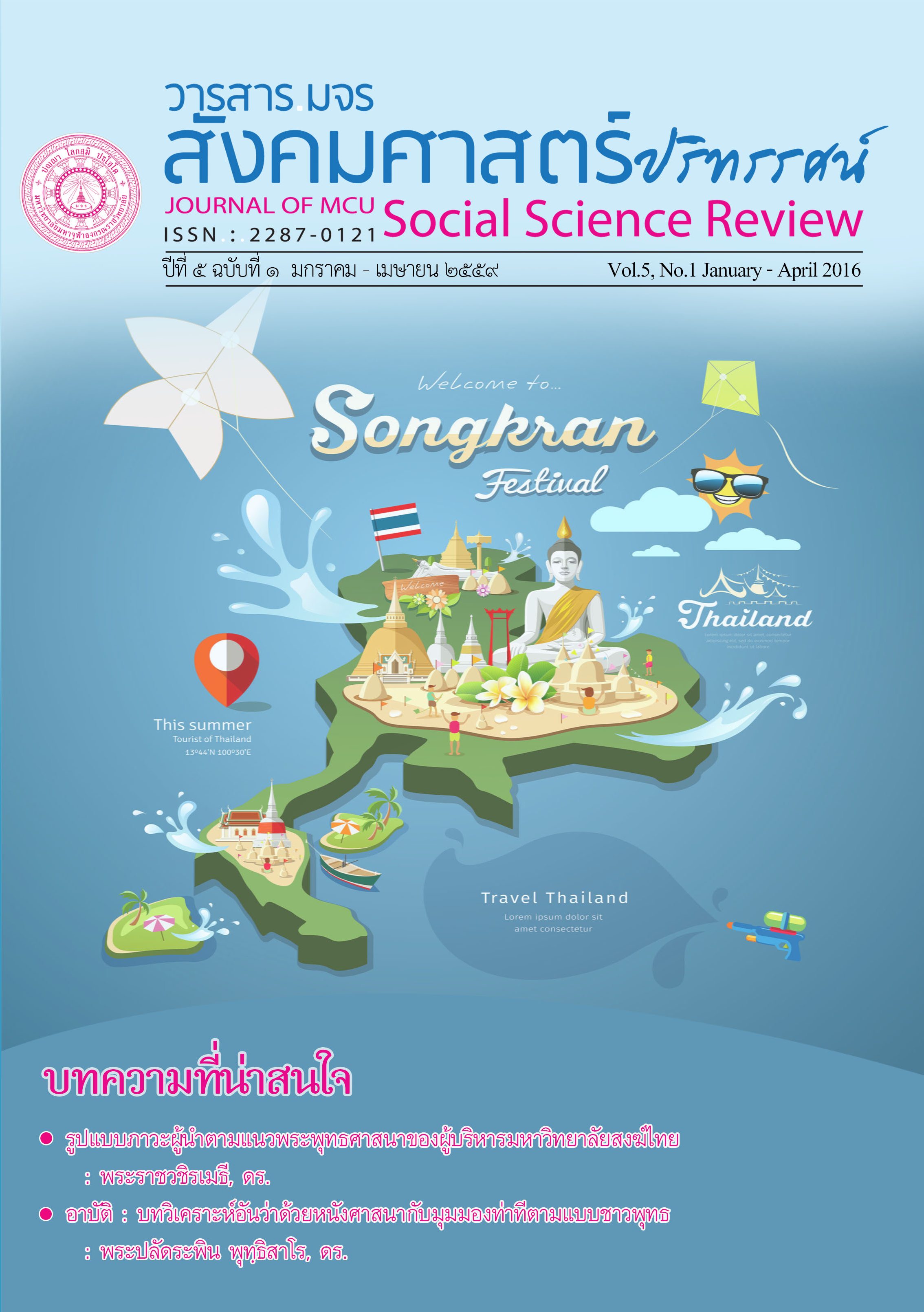การพัฒนารูปแบบการจัดการเรียนการสอนวิชาพระพุทธศาสนา ในโรงเรียนมัธยมศึกษา จังหวัดนครศรีธรรมราช
คำสำคัญ:
การพัฒนารูปแบบ, การจัดการเรียนการสอนบทคัดย่อ
บทความวิจัยนี้ มีวัตถุประสงค์เพื่ ๑) เพื่อศึกษาสภาพการจัดการเรียนการสอนวิชาพระพุทธศาสนาในโรงเรียนมัธยมศึษา จังหวัตนครศรีธรรมราช๒) เพื่อศึกษาแนวดิตทฤษฎีเกี่ยวกัการพัฒนารูปแบบการจัดการเรียนการสอนวิชพระพุทธศาสนาก) เพื่อนำเสนอการพัฒนารูปแบบการบริหารจัดการเรียนกรสอนวิชาพระพุทธศาสนาในโรงเรียนมัธยมศึกษา จังหวัดนครศรีธรรมราชระเบียบวิชีวิจัยเป็นแบบผสานวิธี (Mixed Method Research) ระหว่างการวิจัยเชิงคุณภาพ (Oualitative Research) ที่ใช้กรสัมภาษณ์เชิงล็ก (In-depth Interview) จากผู้ให้ข้อมูลสำคัญ ๒๕ รูป/คน เพื่อหการพัฒนารูปแบบเบื้องตันก่อนน้ำเสนอต่อการสนทนากลุ่มเฉพาะ(Focus Group Discursion) ก่อนจะนำข้อมูลที่ได้นำไปสู่การวิจัยเชิงปริมาณ (QuantitativeResearch)ที่ใช้การศึกษาวิจัยเชิงสำรวจ (Qualitative Research) จากกลุ่มตัวอย่าง ๓๘ด รูป/คนโดยการสุ่มตัวอย่างแบบง่ย เก็บรวบรวมข้อมูลโดยใช้แบบสอบถาม (Questionnaire) กๆรวิเคราะห์ข้อมูลเชิงคุณภาพ วิเคราะห์ข้อมูลที่ไต้จากเอกสาร การสังเกตแบบไม่มีส่วนร่วม การสัมภาษณ์เชิงก ใช้วิธีกรวิเตราะห์ข้อมูลแบบอรรถาธิบายและพรรณนาความ การวิเคราะห์ข้อมูลเชิงปริมาณสถิติที่ใช้ คื ค่ความถี่ ค่ร้อยละ ค่าเฉลี่ย และค่เบี่ยงเบนมาตรฐานผลการวิจัยพบว่า๑. สภาพและปัญหารูปแบบการจัดการเรียนการสอนวิชาพระพุทธศาสนาในโรงเรียนมัธยมศึกษา จังหวัดนครศรีธรรมราช พบว่า ๑ ต้านการจัดการเรียนการสอน คือ จำนวนครูพระสอนวิชาพระพุทธศาสนา ไมพียงพอกับจำนวนนักเรียน ๒ ต้านการใช้สื่อและแหล่งเรียนรู้ คือ สื่อการเรียนการสอนไม่มีความนสนใจ สื่อการเรียนการสอนไม่ทันสมัย ทำให้ง่วงนอนน่าเบื่อ ๓ ต้านบรรยากาศการเรียนรู้ คื โรเรียนมีอคารสถานที่ใช้ในการเรียนการสอนไม่เพียงพอต่อบรรยากาศการเรียนรู้ ขาดห้องประชุม ห้องโสต ห้องวิทยาศาสตร์ ห้องพยาบาล จัดอยู่ในปูชนียสถานเอกเทศตงหากก็ทำให้บรรยกศการเรียนรู้มีน้อย ๔ ต้นกิกรรมการสอน คือ พระภิกษุจัดกิจกรรมการเรียนสอนไม่เรใจทำให้นักเรียนเกิดความนเบื่อและง่วงนอนมาก กิจกรรมการเรียนการสอนที่ไช้เป็นแบบเรียบง่ย๕ ต้านการวัดและประเมินผล คือ ขาดการวัดและประเมินผลตามสภาพจริง ไม่มีการประเมินผลการสอนของครูผู้สอนพระพุทธศาสนา๒.แนวดิตทฤษฎีเกี่ยวกับการพัฒนารูปแบบการจัดการเรียนการสอนวิชาพระพุทธศาสนา พบว่ ๑) กระทรวงศึกษาธิการได้เสนอแนะให้มีการปรับปรุงหลักสูตรพระพุทรศสนาระดับมัธยมศึกษตอนปลาย พุทธศักราช ๒๕๒๔ (ฉบับปรับปรุง พ.ศ.๒:๓ก) โต๋ยมีการเปลี่ยนแปลงคำอธิบายรายวิชาพระพุทธศาสนาเพื่อให้เหมาะสมยิ่งขึ้น และได้เพิ่มวิชาพระพุทรศสนาเป็นวิชเลือกเสรี ในกลุ่มสังคมศึกษา กำหนดให้เรียนสัปดาห์ละ ๒ คาบตลอดภาคเรียนได้ ๑ หน่วยการรียน และกำหนดให้นักเรียนที่นับถือพระพุทธศาสนาทุกคนต้องเรียน โดยเน้นการพัฒนในต้านต่งๆ อย่างแท้จริง ช่น ด้านความรู้ความเข้าใจในเนื้อหา มีเจตคติที่ดีที่ถูกต้องทางพระพุทธศาสนา เกิตศรัทธและสำนึกในความสำคัญของพระพุทธศาสนาที่มีต่อสังคม และสามารถปฏิบัติตตามหน้ที่ชาวพุทธได้อย่างถูกต้องเหมาะสม ตลอดจนนำหลักธรรมทางพระพุทธศาสนาไปปฏิบัติในการดำเนินชีวิตประจำวัน พื่อพัฒนตนเองและสังคม วิชพระพุทธศาสนาเป็นวิชาเลือกในกลุ่มวิชสังคมศึกษา รวม ๘ รายวิชา โดยกลุ่มวิชาสังคมศึกษา เป็นวิชาที่มีความมุ่งหมายในการสร้างพลเมืองของชาติให้มีคุณภาพ สามารถคิดเป็น ทำเป็น และแก้ปัญหาเป็นสามารถปรับตัวให้เข้ากับสิ่งแวดล้อมทาสัดม ได้อย่างปกติ วิชสังคมศึกษาจึงเป็นการศึกษาที่เกี่ยวกับมนุษย์ โดยมีความมุ่งหมายเพื่ผลิตคนให้สามารถตำรงชีวิตอยู่ในสังคมที่มีการเปลี่ยนแปลง ทั้งทางด้านเศรษฐกิจและสังคมอยู่ตลอดเวลา ให้สมารถพัฒนาความรู้ความสามารถ ทักษะ ความรู้สึก หรือค่านิยมที่ดีงามให้แก่คนในสังคม ได้กำหนดจุดประสงค์ของหลักสูตรวิชาสังคมระดับมัธยมศึกษาตอนปลาย๓. การพัฒนรูปแบบการบริหารจัตการเรียนการสอนวิชาพระพุทธศาสนาในโรงเรียนมัธยมศึกษา จังหวัตนครศรีธรรมรช พบว่าต. การบริหารบุคคล ผู้บริหารจัตการเรียนการสอนต้องสนับสนุนงประมาณห้ครูผู้สอนข้ามาสอนวิชพระพุทธศาสนามากขึ้น มีความเหมาะสมต่อจำนวนผู้เรียน ๒. ด้านการใช้สื่และแหล่งเรียนรู้ ผู้สอนต้องผลิตสื่อการเรียนการสอนมาใช้ให้เหมาะสมกับสถานที่ของโรงเรียนซึ่งมีความพร้อม คณะสงฆ์คัตเลือกผู้สอนที่มีทักษะสูงสามารถจัดทำแผนการสอน ผลิตสื่อสนับสนุนครูผู้สอนอย่างต่อเนื่องให้การสอนมีความพร้อมสมบูรณ์ต้านบรรยากาศการเรียนรู้ ครูผู้สอ ผู้บริหารโรงเรียนควรจัดงบประมาณ แสวงหางบประมาณจากภายนอกสนับสนุนการสร้งบรรยกำศ สถานที่ให้เหมาะสามต่อการเรียนรู้ และมีสื่อการสอนที่หนอน ๔. ด้านกิจกรมการสอ มีการจัดกิกรรมการเยนการสอนในรูปแบบออนไลน์ และสื่อที่ระตุ้นความสนไผู้เรียน ๕ ต้นการวัดผลประเมินผล ผู้สอนนำองค์ความรู้จากครูผู้สอนมาสนับสนุนในการวัดผประเมินผลให้เป็นไปตามหลักสูตรของโรงเรียน
เอกสารอ้างอิง
กรมวิชาการ กระทรวงศึกษาธิการ. การจัดการเรียนรู้พระพุทธศาสนา. กรุงเทพมหานคร :โรงพิมพ์ธรรมสภา, ๒๕๔๔.
กิติมา สุรสนธิ. ความรู้ทางการสื่อสาร. กรุงเทพมหานคร: คณะวารสารศาสตร์และสื่อสารมวลชนมหาวิทยาลัยธรรมศาสตร์, ๒๕๔๔.
ปรีชา กันริยะ. คู่มือโครงการพระสอนศีลธรรมในโรงเรียน (การเรียนการสอน) ปีงบประมาณ๒๕๕๐, กรุงทพมหานคร : โรงพิมพ์ชุมชนสหกรณ์การเกษตรแห่งประเทศไทย,
๒๕๕o.
สำนักานพระพุทรศสนาแห่ชาติ. การอบรมค่ายคุณธรรม. กรุงเทพมหานคร : โรงพิมพ์สำนักงานพระพุทธศาสนาแห่งชาติ, ๒๕๔๙.(๒) วิทยานิพนธ์/รายงานการวิจัย
ทิพยรัตน์ สีเพชเหลือง. "รูปแบบและกลยุทธ์การจัดตั้มหาวิทยาลัยบรรษัทในประเทศไทย",วิทยานิพนธ์ครุศสตรดุษฎีบัณฑิต. คณะครุศาสตร์ : จุฬาลงกรณ์มหาวิทยาลัย,
๒๕๕๕.
เบญจนาฏ ควงจิโนและคณะ. "ประสิทธิภาพและประสิทธิผลการดำเนินกิจกรรมการบริการวิชาการของมหาวิทยาลัยสขลานครินทร์". รายงานวิจัย. มหาวิทยาลัยสงขลานครินทร์,
๒๕.๔๗l.
บัณฑิต ตวิโรจน์. "การพัฒนารูปแบบการจัดการเรียนการสอนแบบการจัดการความรู้เพื่อเสริมสร้างสมรรถนะก การสอนของนักศึกษาครู". วิทยานิพนธ์ครุศสตรดุษฎีบัณฑิต,
บัณฑิตวิทยาลัย : จุฬาลงกรณ์มหาวิทยาลัย, ๒๕๕O.
ประเสฐ รรยาสุภาพ. "กพัฒนารูปแบบการกำหนตขนาตโรงเรียนที่เหมาะสมเชิงศรษฐกิจของโรงเรียนมัธยมกษา". วิทยานิพนธ์ครุศาสตรดษฎีบัณฑิต บัณฑิตวิทยาลัย :
จุฬาลงกรณ์มหาวิทยาลัย, ๒๕๔๓.
ประมูล สารพันธ์. "การศึษาแนวทางการพัฒนการศึกษาของคณะสงฆ์". รายงานการวิจัย,สถาบันวิจัยพุทธศาสตร์ : มหาวิทยาลัยมหาจุฬาลงกรณราชวิทยาลัย, ๒๕๕ก.
พรรณี แพ่งล "ตักยภาพการปฏิบัติงานของบัณฑิตโครงการเพิ่มประสิทธิภาพ การบริหารจัตการกองทุนหมู่บ้านแลชุมชนเมืองจังหวัดสมุทรปราการ". รายงานการวิจัย. สำนักวิทย
บริการและเทคโนโลยีสารสนเทศ : มหาวิทยาลัยราชภัฏธนบุรี, ๒๕๔๕.
เยาวภา บัวเวช. "รูปแบบการบริหารงานประชาสัมพันธ์ของมหาวิทยาลัยราชภัฏ", วิทยานิพนธ์ปรัชญาดุษฎีบัณฑิต บัณฑิตวิทยาสัย : มหาวิทยาลัยศิลปากร, ๒๕๕๐.
วราภรณ์ ผ่องสุวรรณ. "การพัฒนารูปแบบการสร้างความรู้ร่วมกันด้วยกระบวนการวิจัยเชิงปฏิบัติการโดยใช้คอมพิวเตอร์สนับสนุนการเรียนรู้ร่วมกัน เพื่อเสริมสร้างทักษะการเรียนเป็นทีของบุคลกรสายสนับสนุนวิชาการสถาบันอุตมศึกษา",วิทยานิพนธ์ครุศสตรดุษฎีบัณฑิต. บัณฑิตวิทยาลัย : จุฬาลงกรณ์มหาวิทยาลัย, ๒๕๕๓.
อมรา รอดตาร. "ผลของการจัดกิกรรมการเรียนการสอนโดยเน้นวิธีคิดแบบสามัญลักษณ์ต่อผลสัมฤทธิ์ทางการเรียนวิชธรรมวิทยาและความพึงพอใจของนิสิตระตับปริญญาบัณฑิตจุฬาลงกรณ์มหาวิทยาลัย ปีการศึกษา๒๕๔๕". รายงานการวิจัย. บัณฑิตวิทยาลัย :จุฬาลงกรณ์มหาวิทยาลัย, ๒๕๔๖.
ดาวน์โหลด
เผยแพร่แล้ว
รูปแบบการอ้างอิง
ฉบับ
ประเภทบทความ
สัญญาอนุญาต
ลิขสิทธิ์ (c) 2016 วารสาร มจร สังคมศาสตร์ปริทรรศน์

อนุญาตภายใต้เงื่อนไข Creative Commons Attribution-NonCommercial-NoDerivatives 4.0 International License.
เพื่อให้เป็นไปตามกฎหมายลิขสิทธิ์ ผู้นิพนธ์ทุกท่านต้องลงลายมือชื่อในแบบฟอร์มใบมอบลิขสิทธิ์บทความให้แก่วารสารฯ พร้อมกับบทความต้นฉบับที่ได้แก้ไขครั้งสุดท้าย นอกจากนี้ ผู้นิพนธ์ทุกท่านต้องยืนยันว่าบทความต้นฉบับที่ส่งมาตีพิมพ์นั้น ได้ส่งมาตีพิมพ์เฉพาะในวารสาร มจร สังคมศาสตร์ปริทรรศน์ เพียงแห่งเดียวเท่านั้น หากมีการใช้ภาพหรือตารางหรือเนื้อหาอื่นๆ ของผู้นิพนธ์อื่นที่ปรากฏในสิ่งตีพิมพ์อื่นมาแล้ว ผู้นิพนธ์ต้องขออนุญาตเจ้าของลิขสิทธิ์ก่อน พร้อมทั้งแสดงหนังสือที่ได้รับการยินยอมต่อบรรณาธิการ ก่อนที่บทความจะได้รับการตีพิมพ์ หากไม่เป็นไปตามข้อกำหนดเบื้องต้น ทางวารสารจะถอดบทความของท่านออกโดยไม่มีข้อยกเว้นใดๆ ทั้งสิ้น





